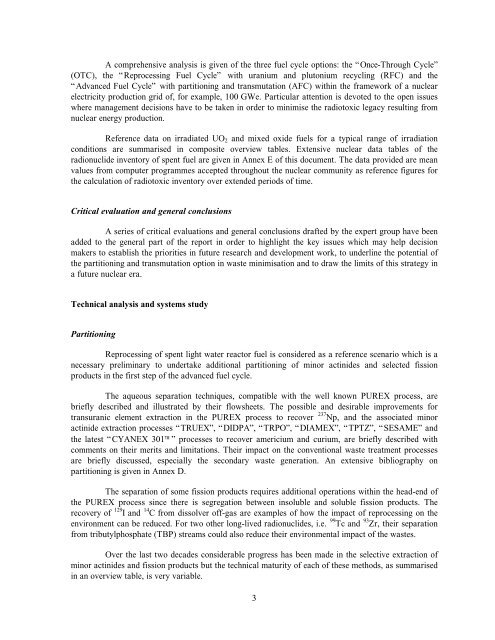COMPLETE DOCUMENT (1862 kb) - OECD Nuclear Energy Agency
COMPLETE DOCUMENT (1862 kb) - OECD Nuclear Energy Agency
COMPLETE DOCUMENT (1862 kb) - OECD Nuclear Energy Agency
Create successful ePaper yourself
Turn your PDF publications into a flip-book with our unique Google optimized e-Paper software.
A comprehensive analysis is given of the three fuel cycle options: the “Once-Through Cycle”<br />
(OTC), the “Reprocessing Fuel Cycle” with uranium and plutonium recycling (RFC) and the<br />
“Advanced Fuel Cycle” with partitioning and transmutation (AFC) within the framework of a nuclear<br />
electricity production grid of, for example, 100 GWe. Particular attention is devoted to the open issues<br />
where management decisions have to be taken in order to minimise the radiotoxic legacy resulting from<br />
nuclear energy production.<br />
Reference data on irradiated UO 2 and mixed oxide fuels for a typical range of irradiation<br />
conditions are summarised in composite overview tables. Extensive nuclear data tables of the<br />
radionuclide inventory of spent fuel are given in Annex E of this document. The data provided are mean<br />
values from computer programmes accepted throughout the nuclear community as reference figures for<br />
the calculation of radiotoxic inventory over extended periods of time.<br />
Critical evaluation and general conclusions<br />
A series of critical evaluations and general conclusions drafted by the expert group have been<br />
added to the general part of the report in order to highlight the key issues which may help decision<br />
makers to establish the priorities in future research and development work, to underline the potential of<br />
the partitioning and transmutation option in waste minimisation and to draw the limits of this strategy in<br />
a future nuclear era.<br />
Technical analysis and systems study<br />
Partitioning<br />
Reprocessing of spent light water reactor fuel is considered as a reference scenario which is a<br />
necessary preliminary to undertake additional partitioning of minor actinides and selected fission<br />
products in the first step of the advanced fuel cycle.<br />
The aqueous separation techniques, compatible with the well known PUREX process, are<br />
briefly described and illustrated by their flowsheets. The possible and desirable improvements for<br />
transuranic element extraction in the PUREX process to recover 237 Np, and the associated minor<br />
actinide extraction processes “TRUEX”, “DIDPA”, “TRPO”, “DIAMEX”, “TPTZ”, “SESAME” and<br />
the latest “CYANEX 301” processes to recover americium and curium, are briefly described with<br />
comments on their merits and limitations. Their impact on the conventional waste treatment processes<br />
are briefly discussed, especially the secondary waste generation. An extensive bibliography on<br />
partitioning is given in Annex D.<br />
The separation of some fission products requires additional operations within the head-end of<br />
the PUREX process since there is segregation between insoluble and soluble fission products. The<br />
recovery of 129 I and 14 C from dissolver off-gas are examples of how the impact of reprocessing on the<br />
environment can be reduced. For two other long-lived radionuclides, i.e. 99 Tc and 93 Zr, their separation<br />
from tributylphosphate (TBP) streams could also reduce their environmental impact of the wastes.<br />
Over the last two decades considerable progress has been made in the selective extraction of<br />
minor actinides and fission products but the technical maturity of each of these methods, as summarised<br />
in an overview table, is very variable.<br />
3
















